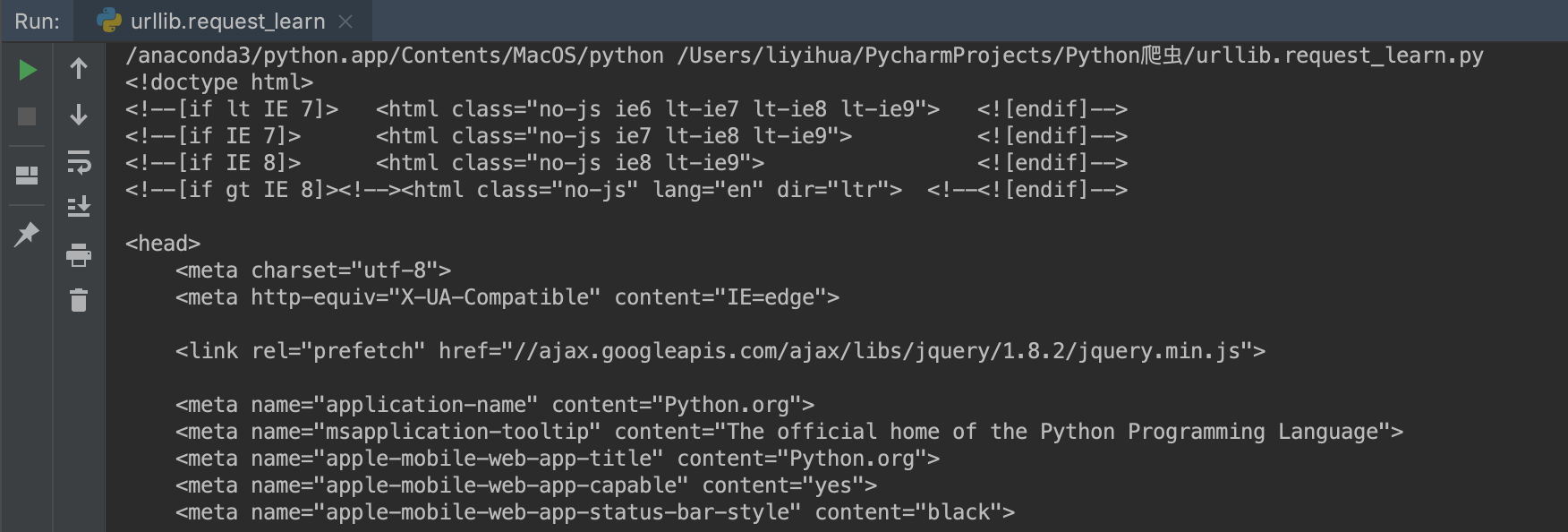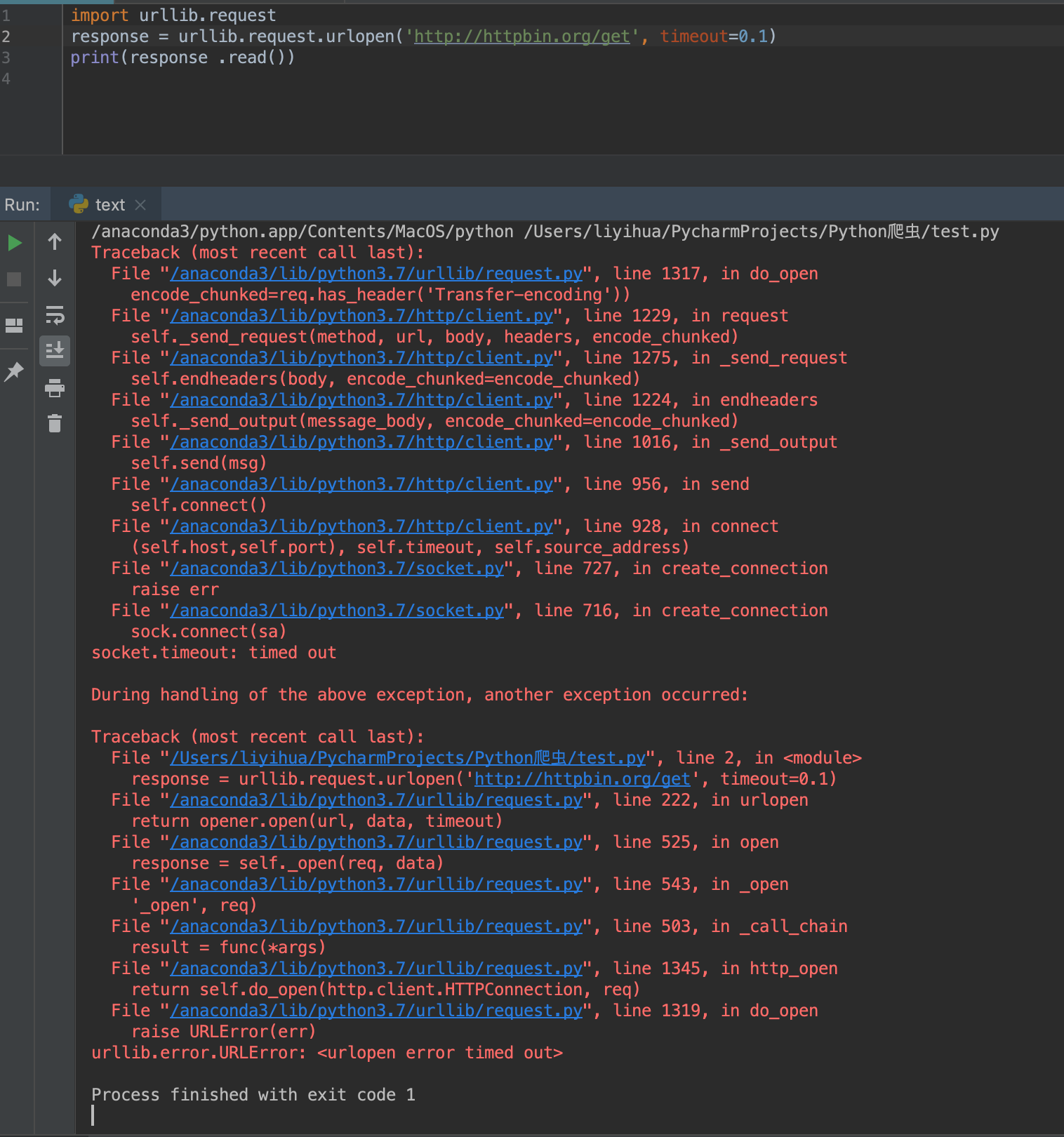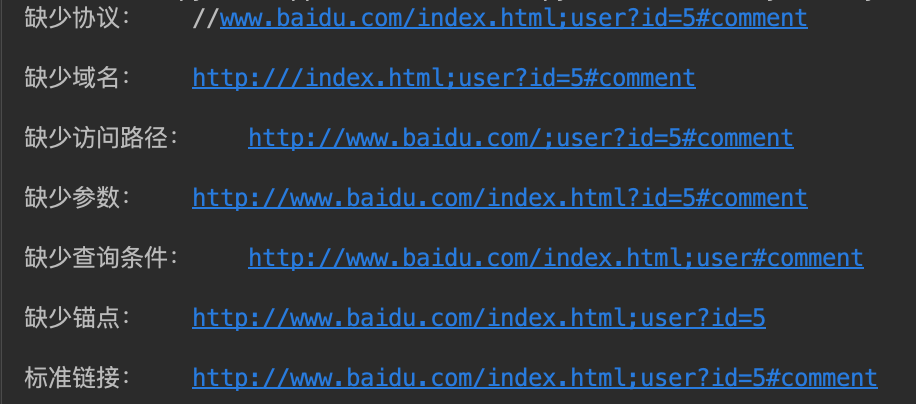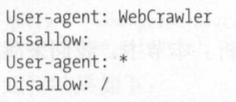爬虫基本库的使用---urllib库
使用urllib---Python内置的HTTP请求模块
- urllib包含模块:request模块、error模块、parse模块、robotparser模块
发送请求
- 使用 urllib 的 request模块,实现请求的发送并得到响应
urlopen()
- 用urllib.request 里的urlopen()方法发送一个请求
- 输入:
- import urllib.request
- # 向指定的url发送请求,并返回服务器响应的类文件对象
- response = urllib.request.urlopen('https://www.python.org') # 这里所指定的url是https://www.python.org
- # read()方法读取文件全部内容
- html = response.read()
- # decode()的作用是将其他编码的字符串转换成unicode编码
- print(html.decode('utf-8'))
- 部分输出:

涉及方法decode()---该方法返回解码后的字符串。其中有编码方法encode()
- 备注:urllib.request 里的 urlopen()不支持构造HTTP请求,不能给编写的请求添加head,无法模拟真实的浏览器发送请求。
type()方法输出响应的类型:
- import urllib.request
- # 向指定的url发送请求,并返回服务器响应的类文件对象
- response = urllib.request.urlopen('https://www.python.org')
- print(type(response))
- # 输出结果如下:
- <class 'http.client.HTTPResponse'>
- # 它是一个 HTTPResposne类型的对象,主要包含 read()、 readinto()、 getheader(name)、getheaders()、 fileno()等方法,以及 msg、 version、 status、 reason、 debuglevel、 ιlosed等属性
- 实例(部分方法或属性):
- import urllib.request
- response = urllib.request.urlopen('https://www.python.org')
- print(response.status) # status属性:返回响应的状态码,如200代表请求成功
- print(response.getheaders()) # getheaders()方法:返回响应的头信息
- print(response.getheader('Server')) # getheader('name')方法:获取响应头中的name值
- # 输出:
- 200
- [('Server', 'nginx'), ('Content-Type', 'text/html; charset=utf-8'), ('X-Frame-Options', 'DENY'), ('Via', '1.1 vegur'), ('Via', '1.1 varnish'), ('Content-Length', ''), ('Accept-Ranges', 'bytes'), ('Date', 'Fri, 14 Jun 2019 04:36:05 GMT'), ('Via', '1.1 varnish'), ('Age', ''), ('Connection', 'close'), ('X-Served-By', 'cache-iad2125-IAD, cache-hnd18748-HND'), ('X-Cache', 'HIT, HIT'), ('X-Cache-Hits', '3, 736'), ('X-Timer', 'S1560486966.523393,VS0,VE0'), ('Vary', 'Cookie'), ('Strict-Transport-Security', 'max-age=63072000; includeSubDomains')]
- nginx
- urllib.request.urlopen(url, data=None, [timeout,]*, cafile=None, capath=None, cadefault=False, context=None)
重要参数:
url:可以是请求的链接,也可以是请求(Request)的对象;
data: 请求中附加送给服务器的数据(如:用户名和密码等);
timeout:超时的时间,以秒为单位,超过多长时间即报错;- data参数
- 使用参数data,需要使用bytes()方法将参数转化为字节流编码格式的内容,即bytes类型
实例:
- import urllib.parse
- import urllib.request
- data = bytes(urllib.parse.urlencode({'word': 'hello'}), encoding='utf-8')
- response = urllib.request.urlopen('http://httpbin.org/post', data=data)
- print(response.read())

# 请求的站点是httpbin.org,它可以提供HTTP测试请求。
# 次例子中的URL是http://httpbin.org/post,这个链接可以用来测试POST请求,
# 它可以输出请求的一些信息,其中包含我们传递的data参数
代码使用的其他方法:
- urllib.parse模块里的urlencode()方法将参数字典转化为字符串
- bytes() 返回值为一个新的不可修改字节数组,每个数字元素都必须在0 - 255范围内,和bytearray函数的具有相同的行为,差别仅仅是返回的字节数组不可修改
- # bytes([source[, encoding[, errors]]])
- # 第一个参数需要是str(字符串)类型
- # 第二个参数指定编码格式
- # 如果没有输入任何参数,默认就是初始化数组为0个元素
- # 例如
- byte = bytes('LiYihua', encoding='utf-8')
- print(byte)
- # 输出:
- b'LiYihua'
- # bytes([source[, encoding[, errors]]])
- timeout参数
- timeout参数用于设置超时时间,单位为秒,即如果请求超出了设置的这个时间, 还没有得到响应 , 就会抛出异常。
- 例子1:

该程序在运行时间0.1s过后,服务器没有响应,于是抛出错误URL Error异常(错误原因是超时)
- 例子2:
- import socket
- import urllib.request
- import urllib.error
- try:
- response = urllib.request.urlopen('http://httpbin.org/get', timeout=0.1) # 设置超时时间0.1s
- except urllib.error.URLError as e:
- # 判断异常是socket.timeout类型(意思就是超时异常) e.reason获取的是错误的原因
- if isinstance(e.reason, socket.timeout):
- print('TIME OUT')
- # 输出:
- TIME OUT
- 在python中:
- e 一般是捕捉到的错误对象
- e.code 是错误代码
- e.reason获取的是错误的原因
其他参数
- import socket
- context参数,它必须是ssl.SSLContext类型,用来指定SSL设置
- cafile和capath两个参数分别是指定CA证书和它的路径,这个在请求HTTPS链接时会有用
Request
- urlopen()方法可以实现最基本请求的发起,Request更强大(比urlopen()方法)
- Request例子:
- import urllib.request
- request = urllib.request.Request('https://python.org') # 将请求独立成一个对象
- response = urllib.request.urlopen(request) # 同样用urlopen()方法来发送请求
- print(response.read().decode('utf-8'))
- # 输出:
- <!doctype html>
- <!--[if lt IE 7]> <html class="no-js ie6 lt-ie7 lt-ie8 lt-ie9"> <![endif]-->
- <!--[if IE 7]> <html class="no-js ie7 lt-ie8 lt-ie9"> <![endif]-->
- <!--[if IE 8]> <html class="no-js ie8 lt-ie9"> <![endif]-->
- <!--[if gt IE 8]><!--><html class="no-js" lang="en" dir="ltr"> <!--<![endif]-->
- <head>
- <meta charset="utf-8">..............
- ....................此处省略XXX字符
- <![endif]-->
- <!--[if lte IE 8]>
- <script type="text/javascript" src="/static/js/plugins/getComputedStyle-min.c3860be1d290.js" charset="utf-8"></script>
- <![endif]-->
- </body>
- </html>
- class urllib.request.Request(url, data=None, headers={ }, origin_req_host=None, unverifiable=False, mothod=None)
- url参数: 请求URL
- data参数:Post 提交的数据, 默认为 None ,当 data 不为 None 时, urlopen() 提交方式为 Post
- headers参数:也就是请求头,headers参数可以在构造请求时使用,也可以用add_header()方法来添加
- 请求头最常用的用法:修改User-Agent来伪装浏览器(如伪装Firefox:
Mozilla/s.o (X11; U; Linux i686) Gecko/20071127 Firefox/2.0.0.11
)
- origin_req_host参数:指的是请求方的host名称或者IP地址
unverifiable参数:
表示这个请求是否是无法验证 的,默认是 False,意思就是说用户没
有足够权限来选择接收这个请求的结果。 例如,我们请求一个 HTML文档中的图片,但是我
们没有向动抓取图像的权限,这时 unverifiable 的值就是 True。
- method参数:它是一个字符串,用来指示请求使用的方法(如:GET、POST、PUT等)
- 例子:
- from urllib import request, parse
- url = 'https://python.org/post' # 要请求的URL
- headers = {
- 'User-Agent': 'Mozilla/4.0 (compatible; MSIE 5.5; Windows NT',
- 'Host': 'httpbin.org'
- } # 指定请求头User-Agent,Host
- dict = {
- 'name': 'Germey'
- } # 要提交的数据
- data = bytes(parse.urlencode(dict), encoding='utf-8') # 要提交的数据是dict类型,先用bytes()方法,将其转为字符串
- req = request.Request(url=url, data=data, headers=headers, method='POST')
- # 这里使用Request()方法,用了四个参数
- response = request.urlopen(req) # urlopen()发送请求
- print(response.read().decode('utf-8')) # 用decode()方法,解码所获得的字符串,即读取到的response,解码格式为utf-8
- # 输出:
- {
- "args”:{},
- ”data”: ""
- "files”{},
- ” form": {
- ”name”:”Germey”
- },
- ”headers”:{
- ”Accept-Encoding”.”identity”,
- ”Content-Length " : ” 11”, "Content-Type”·”application/x-www-form- urlencoded”, ”Host”·”httpbin.org”,
- ”User-Agent”:”问。zilla/4.0 (compatible;问SIE S.S; Windows NT)”
- },
- "json": null,
- ”origin”.”219.224.169.11”,
- ” url ” : ” http://httpbin.org/post ”
- }
add_header()方法来添加headers
- req =request.Request(url=url, data=data, method='POST’)
- req .add_header('User-Agent', 'Mozilla/4 .0 (compatible; MSIE 5.5; Windows NT)')
高级用法
- Request虽然可以构造请求,但是对于一些更高级的操作(比如Cookies处理,代理设置等),就需要更强大的工具Handler了
BaseHandler
- 各种Handler子类继承BaseHandler类
- 部分例子:
HITPDefaultErrorHandler:用于处理HTTP响应错误,错误都会抛出 HTTPError类型的异常。
HTTPRedirectHandler:用于处理重定向 。
HTTPCookieProcessor: 用于处理 Cookies。
ProxyHandler:用于设置代理 , 默认代理为空 。
HπPPasswordMgr:用于管理密码,它维护了用户名和密码的表。
HTTPBasicAuthHandler: 用于管理认证,如果一个链接打开时需要认证,那么可以用它来解决认证问题 。
Handler类官方文档:https://docs.python.org/3/library/urllib.request.html#urllib.request.BaseHandler
- 部分例子:
验证
:在登录某些网站时,需要输入用户名和密码,验证成功后才能查看页面,这时可以借助HTTPBasicAuthHandler
- from urllib.request import HTTPPasswordMgrWithDefaultRealm, HTTPBasicAuthHandler, build_opener
- from urllib.error import URLError
- username = 'username'
- password = 'password'
- url = 'http://localhost:5000/'
- p = HTTPPasswordMgrWithDefaultRealm() # 创建一个密码管理对象,用来保存 HTTP 请求相关的用户名和密码
- p.add_password(None, url, username, password) # 添加url,用户名,密码
- auth_handler = HTTPBasicAuthHandler(p) # 来处理代理的身份验证
- opener = build_opener(auth_handler) # 利用build_opener()方法构建一个Opener
- try:
- result = opener.open(url) # 利用Opener的open()方法打开链接,完成验证
- html = result.read().decode('utf-8') # 读取返回的结果,解码返回结果
- print(html)
- except URLError as e:
- print(e.reason) # 获取错误的原因
可以修改username、password、url来爬取自己想爬取的网站
- from urllib.request import HTTPPasswordMgrWithDefaultRealm, HTTPBasicAuthHandler, build_opener
代理
- from urllib.error import URLError
- from urllib.request import ProxyHandler, build_opener
- # ProxyHandler()使用代理IP, 它的参数是一个字典,键名是协议类型(比如HTTP或者HTTPS等),键值是代理链接,可以添加多个代理
- proxy_handler = ProxyHandler(
- {
- 'http': 'http://127.0.0.1:9743',
- 'https': 'https://127.0.0.1:9743'
- }
- )
- opener = build_opener(proxy_handler) # 利用build_opener()方法,构造一个Opener
- try:
- response = opener.open('https://www.baidu.com') # 发送请求
- print(response.read().decode('utf-8'))
- except URLError as e:
- print(e.reason)
- from urllib.error import URLError
Cookies
- 爬一些需要登录的网站,就要用到cookie相关的一些模块来操作了
http.cookiejar.CookieJar()
- import http.cookiejar
- # http.cookiejar.CookieJar()
- # 1、管理储存cookie,向传出的http请求添加cookie
- # 2、cookie存储在内存中,CookieJar示例回收后cookie将自动消失
- import urllib.request
- cookie = http.cookiejar.CookieJar() # 创建cookiejar实例对象
- handler = urllib.request.HTTPCookieProcessor(cookie) # 根据创建的cookie生成cookie的管理器
- opener = urllib.request.build_opener(handler)
- response = opener.open('http://www.baidu.com')
- for item in cookie:
- print(item.name+"="+item.value)
- # 输出
- BAIDUID=FB2B1F3E51F9DD2626C586989E016F7B:FG=1
- BIDUPSID=FB2B1F3E51F9DD2626C586989E016F7B
- H_PS_PSSID=29272_1443_21084_29135_29238_28519_29098_29369_28839_29221_20718
- PSTM=1560654641
- delPer=0
- BDSVRTM=0
- BD_HOME=0
- import http.cookiejar
http.cookiejar.MozillaCookiejar()
- 该方法在生成文件时用到,可以用来处理Cookies和文件相关的事件,比如读取和保存Cookies,可以将Cookies保存成Mozilla型浏览器的Cookies格式
- import http.cookiejar
- # http.cookiejar.MozillaCookiejar
- # 1、是FileCookieJar的子类
- # 2、与moccilla浏览器兼容
- import urllib.request
- file_name = 'cookies.txt'
- cookie = http.cookiejar.MozillaCookieJar(file_name) # 创建cookiejar实例对象
- handler = urllib.request.HTTPCookieProcessor(cookie) # 根据创建的cookie生成cookie的管理器
- opener = urllib.request.build_opener(handler)
- response = opener.open('http://www.baidu.com')
- cookie.save(ignore_discard=True, ignore_expires=True) # 保存cookie到文件
- # 运行后,生成文件cookies.txt,文件内容如下

- import http.cookiejar
http.cookiejar.LWPCookieJar()
LWPCookieJar,可以保存Cookies,保存成
libwww-perl
- (LWP)格式的Cookies文件
- LwpCookieJar
- 是FileCookieJar的子类
- 与libwww-perl标准兼容
- 改变上面一个代码例子中的一句代码
- 将
- cookie = http.cookiejar.MozillaCookieJar(file_name)
- 改为
- cookie = http.cookiejar.LWPCookieJar(file_name)
- # 运行后,生成一个文件cookies.txt,文件内容如下

读取并利用 生成的Cookies文件
- 例如打开LWPCookies格式文件
- import http.cookiejar
- import urllib.request
- cookie = http.cookiejar.LWPCookieJar() # 创建cookiejar实例对象
- cookie.load('cookies.txt', ignore_discard=True, ignore_expires=True) # load()方法来读取本地的Cookies文件
- handler = urllib.request.HTTPCookieProcessor(cookie) # 根据创建的cookie生成cookie的管理器
- opener = urllib.request.build_opener(handler) # 利用build_opener()方法,构造一个Opener
- response = opener.open('http://www.baidu.com') # 利用Opener的open()方法打开链接,发送请求
- print(response.read().decode('utf-8')) # 读取、解码
运行结果正常的话,会输出百度网页的源代码
- import http.cookiejar
处理异常
URLError
- from urllib import request, error
- try:
- response = request.urlopen('https://www.bucunzai_tan90.com/index.htm')
- print(response.read().decode('utf8'))
- except error.URLError as e:
- print(e.reason)
- # 打开一个不存在的页面时,输出结果是:[Errno 8] nodename nor servname provided, or not known
- # 打开一个存在的页面时,输出结果是网页的源代码
- from urllib import request, error
HTTPError
- 它是URLError的子类,专门用来处理HTTP请求错误,比如认证请求失败等
code: 返回 HTTP状态码,比如 404表示网页不存在, 500表示服务器内部错误等。
reason:同父类一样,用于返回错误的原因 。
headers: 返回请求头。
- from urllib import request, error
- try:
- response = request.urlopen('https://cuiqingcai.com/index.htm')
- print(response.read().decode('utf8'))
- except error.HTTPError as e:
- print(e.reason, e.code, e.headers, sep='\n\n')
- # 参数sep是实现分隔符,比如多个参数输出时想要输出中间的分隔字符
- # 输出结果:
- Not Found
- 404
- Server: nginx/1.10.3 (Ubuntu)
- Date: Sun, 16 Jun 2019 10:53:09 GMT
- Content-Type: text/html; charset=UTF-8
- Transfer-Encoding: chunked
- Connection: close
- Set-Cookie: PHPSESSID=vrvrfqq88eck9speankj0ogus0; path=/
- Pragma: no-cache
- Vary: Cookie
- Expires: Wed, 11 Jan 1984 05:00:00 GMT
- Cache-Control: no-cache, must-revalidate, max-age=0
- Link: <https://cuiqingcai.com/wp-json/>; rel="https://api.w.org/"
index.html通常是一个网站的首页,也叫导航页,也就是在这个页面上包含了网站上的基本链接
- # 更好的写法是,先处理子类,再处理父类,最后处理正常逻辑
- from urllib import request, error
- try:
- response = request.urlopen('https://cuiqingcai.com/index.htm')
- # print(response.read().decode('utf8'))
- except error.HTTPError as e: # 处理HTTPError子类
- print(e.reason, e.code, e.headers, sep='\n\n')
- except error.URLError as e: # 处理URLError父类
- print(e.reason)
- else: # 处理正常逻辑
- print('Request Successful')
关于上面的reason属性,返回的不一定是字符串,也可能是一个对象。如返回: <class 'socket.timeout'> 等等
- from urllib import request, error
- 它是URLError的子类,专门用来处理HTTP请求错误,比如认证请求失败等
解析链接
- ullib.parse定义了处理URL的标准接口
- 它支持file、ftp、 hdl、 https、 imap、mms 、 news 、 prospero 、 telnet等协议的URL处理
urlparse()
- 实现URL的识别和分段
- from urllib.parse import urlparse
- # 实现URL的分段
- result = urlparse('http://www.baidu.com/index.html;user?id=5#comment')
- print(type(result), result, sep='\n') # 输出的result是一个元组
- # 输出:
- <class 'urllib.parse.ParseResult'>
- ParseResult(scheme='http', netloc='www.baidu.com', path='/index.html', params='user', query='id=5', fragment='comment')
- # scheme='协议', netloc='域名', path='访问路径', params='参数', query='查询条件'(?后面), fragment='锚点'(#号后面)
网页链接标准格式 scheme://netloc/path ;params?query#fragment
urllib.parse.urlparse(urlstring, scheme='', allwo_fragments=True)
uelstring:要解析的URL。 scheme:所给URL没协议时,scheme='XXX',XXX是默认协议,否则scheme='所给URL协议'。
allwo_fragments:是否可以忽略fragament。
- 实现URL的识别和分段
urlunparse()
- 实现URL的构造:
- from urllib.parse import urlunparse
- # urllib.parse.urlunparse(),接受的参数是一个可迭代对象,它的长度必须是6
- # 这里的data用了列表,也可以用元组或者特定的数据结构
- data1 = ['http', 'www.baidu.com', '/index.html', 'user', 'id=5', 'comment']
- data2 = ['', 'www.baidu.com', '/index.html', 'user', 'id=5', 'comment']
- data3 = ['http', '', '/index.html', 'user', 'id=5', 'comment']
- data4 = ['http', 'www.baidu.com', '', 'user', 'id=5', 'comment']
- data5 = ['http', 'www.baidu.com', '/index.html', '', 'id=5', 'comment']
- data6 = ['http', 'www.baidu.com', '/index.html', 'user', '', 'comment']
- data7 = ['http', 'www.baidu.com', '/index.html', 'user', 'id=5', '']
- print("缺少协议:\t"+urlunparse(data2), "缺少域名:\t"+urlunparse(data3),
- "缺少访问路径:\t"+urlunparse(data4), "缺少参数:\t"+urlunparse(data5),
- "缺少查询条件:\t"+urlunparse(data6), "缺少锚点:\t"+urlunparse(data7),
- "标准链接:\t"+urlunparse(data1), sep='\n\n')
- # 输出对比:

- from urllib.parse import urlunparse
- 实现URL的构造:
urlsplit()
- 实现URL的识别和分段:
- from urllib.parse import urlsplit
- result = urlsplit('http://www.baidu.com/index.html;user?id=5#comment')
- print(result, result.scheme, result[4], sep='\n')
- # 输出结果:
- SplitResult(scheme='http', netloc='www.baidu.com', path='/index.html;user', query='id=5', fragment='comment')
- http
- comment
- # urlsplit()方法与urlparse()方法很相似,urlsplit()方法与urlparse()相比,urlsplit()将path和params合在一起放在path中,而urlparse()中,path和params是分开的
- 实现URL的识别和分段:
urlunsplit()
- 实现URL的构造:
- from urllib.parse import urlunsplit
- # urlunsplit()方法与urlunparse()方法类似,urlunsplit()传入的参数是一个可迭代的对象,
- # 不同之处是path和params是否合在一起(urlunsplit是合在一起的)
- data = ('http', 'wwww.baidu.com', 'index.html;user', 'id=5', 'comment')
- print(urlunsplit(data))
- # 输出结果:
- http://wwww.baidu.com/index.html;user?id=5#comment
- from urllib.parse import urlunsplit
urljoin()
- 完成链接的合并:
- from urllib.parse import urljoin
- # 完成链接的合并(前提是必须有特定长度的对象,链接的每一部分都要清晰分开)
- print(urljoin('http://www.baidu.com', 'FAQ.html'))
- print(urljoin('http://www.baidu.com', 'https://cuiqingcai.com/FAQ.html'))
- print(urljoin ('http://www.baidu.com/about.html', 'https://cuiqingcai.com/FAQ.html'))
- print(urljoin('http://www.baidu.com/about.html', 'https://cuiqingcai.com/FAQ.html?question=2'))
- print(urljoin ('http://www.baidu.com d=abc', 'https://cuiqingcai.com/index.php'))
- print(urljoin('http://www.baidu.com', '?category=2#comment'))
- print(urljoin('www.baidu.com', '?category=2#comment'))
- print(urljoin('www.baidu.com#comment', '?category=2'))
- # 输出:
- http://www.baidu.com/FAQ.html
https://cuiqingcai.com/FAQ.html - https://cuiqingcai.com/FAQ.html
- https://cuiqingcai.com/FAQ.html?question=2
- https://cuiqingcai.com/index.php
- http://www.baidu.com?category=2#comment
- www.baidu.com?category=2#comment
- www.baidu.com?category=2
- 完成链接的合并:
urlencode()
- urlencode()可以把key-value这样的键值对转换成我们想要的格式,返回的是a=1&b=2这样的字符串
- from urllib.parse import urlencode
- params = {}
- params['name'] = 'Tom'
- params['age'] = 21
- base_url = 'http://wwww.baidu.com?'
- url = base_url + urlencode(params)
- print(url)
- # 输出:
- http://wwww.baidu.com?name=Tom&age=21
- urlencode()可以把key-value这样的键值对转换成我们想要的格式,返回的是a=1&b=2这样的字符串
- parse_qs()
- 如果说urlencode()方法实现序列化,那么parse_qs()就是反序列化
- from urllib.parse import parse_qs
- query = 'name=Tom&age=21'
- print(parse_qs(query))
- # 输出:
- {'name': ['Tom'], 'age': ['']}
- 如果说urlencode()方法实现序列化,那么parse_qs()就是反序列化
parse_qsl()
- parse_qsl()方法与parse_qs()方法很相似,parse_qsl()返回的是列表,列表中的每个元素是一个元组,parse_qs()返回的是字典
- from urllib.parse import parse_qsl
- query = 'name=Tom&age=21'
- print(parse_qsl(query))
- # 输出:
- [('name', 'Tom'), ('age', '')]
- parse_qsl()方法与parse_qs()方法很相似,parse_qsl()返回的是列表,列表中的每个元素是一个元组,parse_qs()返回的是字典
quote()
- 将内容转化为URL编码的格式
- from urllib.parse import quote
- keyword = '壁纸'
- url = 'https://www.baidu.com/s?wd=' + quote(keyword)
- print(url)
- # 输出:
- https://www.baidu.com/s?wd=%E5%A3%81%E7%BA%B8
- 将内容转化为URL编码的格式
unquote()
- 进行URL解码
- from urllib.parse import unquote
- url = 'https://www.baidu.com/s?wd=%E5%A3%81%E7%BA%B8'
- print(unquote(url))
- # 输出:
- https://www.baidu.com/s?wd=壁纸
- 进行URL解码
分析Robots协议
Robots协议(爬虫协议、机器人协议)---网络爬虫排除标准(Robots Exclusion Protocol)
- 爬虫访问一个站点时,它首先会检查这个站点根目录下是否存在robots.txt文件,如果存在,搜索爬虫会根据其中定义的范围来爬取。
- robots.txt样例:

User-agent: Baiduspider 代表规则对百度爬虫是有效的(还有很多,例如Googlebot、360Spider等)




常见爬虫名称

robotparser
- urllib.robotparser.RobotFileParser(url='')根据某网站的robots.txt文件来判断一个爬取爬虫是否有权限来爬取这个网页
- set_url() 用来设置robot.txt文件的链接
- read() 读取robots.txt文件并进行分析
- parse() 解析robots.txt文件,传入的参数是robots.txt某些行内容
- can_fetch(User-agent='', URL='') 返回内容是该搜索引擎是否可以抓取这个URL,返回结果是True或False
- mtime() 返回上一次抓取和分析robots.txt的时间
- modified() 将当前时间设置为上次抓取和分析robots.txt的时间
- from urllib.robotparser import RobotFileParser
- rp = RobotFileParser()
- rp.set_url('http://www.jianshu.com/robots.txt') # 设置robots.txt文件的链接
- rp.read() # 读取robots.txt文件并进行分析
- print(rp.can_fetch('*', 'http://www.jianshu.com/p/b67554025d7d')) # 输出该搜索引擎是否可以抓取这个URL
- print(rp.can_fetch('*', 'http://www.jianshu.com/search?q=python&page=1&type=collections'))
- # 输出:
- False
- False
- # False也就是说该搜索引擎不能抓取这个URL
- from urllib.robotparser import RobotFileParser
- from urllib.request import urlopen
- rp = RobotFileParser()
- rp.parse(urlopen('http://www.jianshu.com/robots.txt').read().decode('utf-8').split('\n'))
- print(rp.can_fetch('*', 'http://www.jianshu.com/p/b67554025d7d'))
- print(rp.can_fetch('*', 'http://www.jianshu.com/search?q=python&page=1&type=collections'))
- # 输出结果与上面一个例子一样,只是上一个例子用read()方法,这个例子用parse()方法
- from urllib.robotparser import RobotFileParser
- urllib.robotparser.RobotFileParser(url='')根据某网站的robots.txt文件来判断一个爬取爬虫是否有权限来爬取这个网页
- urllib包含模块:request模块、error模块、parse模块、robotparser模块
爬虫基本库的使用---urllib库的更多相关文章
- python爬虫---从零开始(二)Urllib库
接上文再继续我们的爬虫,这次我们来述说Urllib库 1,什么是Urllib库 Urllib库是python内置的HTTP请求库 urllib.request 请求模块 urllib.error 异常 ...
- 【Python爬虫】HTTP基础和urllib库、requests库的使用
引言: 一个网络爬虫的编写主要可以分为三个部分: 1.获取网页 2.提取信息 3.分析信息 本文主要介绍第一部分,如何用Python内置的库urllib和第三方库requests库来完成网页的获取.阅 ...
- Python爬虫(2):urllib库
爬虫常用库urllib 注:运行环境为PyCharm urllib是Python3内置的HTTP请求库 urllib.request:请求模块 urllib.error:异常处理模块 urllib.p ...
- 爬虫(二):Urllib库详解
什么是Urllib: python内置的HTTP请求库 urllib.request : 请求模块 urllib.error : 异常处理模块 urllib.parse: url解析模块 urllib ...
- 爬虫(三)-之Urllib库的基本使用
什么是Urllib Urllib是python内置的HTTP请求库 包括以下模块 urllib.request 请求模块 urllib.error 异常处理模块 urllib.parse url解 ...
- python爬虫之urllib库(一)
python爬虫之urllib库(一) urllib库 urllib库是python提供的一种用于操作URL的模块,python2中是urllib和urllib2两个库文件,python3中整合在了u ...
- python爬虫 - Urllib库及cookie的使用
http://blog.csdn.net/pipisorry/article/details/47905781 lz提示一点,python3中urllib包括了py2中的urllib+urllib2. ...
- 对于python爬虫urllib库的一些理解(抽空更新)
urllib库是Python中一个最基本的网络请求库.可以模拟浏览器的行为,向指定的服务器发送一个请求,并可以保存服务器返回的数据. urlopen函数: 在Python3的urllib库中,所有和网 ...
- (爬虫)urllib库
一.爬虫简介 什么是爬虫?通俗来讲爬虫就是爬取网页数据的程序. 要了解爬虫,还需要了解HTTP协议和HTTPS协议:HTTP协议是超文本传输协议,是一种发布和接收HTML页面的传输协议:HTTPS协议 ...
随机推荐
- 03-css的继承性和层叠性
一.继承性 css中所谓的继承,就是子集继承父级的属性. 可以继承的属性:color.font-xxx.text-xxx.line-xxx.(主要是文本级的标签元素) 但是,像一些盒子元素属性,定位的 ...
- 下载git2.2.1并将git添加到环境变量中
># wget https://github.com/git/git/archive/v2.2.1.tar.gz > # tar zxvf v2.2.1.tar.gz ># cd g ...
- SpringMvc问题记录-Controller对于静态变量的访问分析
问题描述 在于朋友的讨论中分析到一种场景,即:Controller对于一个类中的静态变量进行访问时,如果第一个接口修改该静态变量的数据,另外一个接口获取该静态变量的数据,那么返回的结果是什么? 操作步 ...
- [Machine Learning] Linear regression
1. Variable definitions m : training examples' count \(y\) : \(X\) : design matrix. each row of \(X\ ...
- Scala 占位符在REPL和Eclipse/IDEA中初始化变量问题
占位符在REPL和Eclipse/IDEA中初始化变量问题: 占位符初始化,如果是局部变量,都会报错!只能在全局变量中使用! REPL: Eclipse: IDEA: 如果是类的属性,却就是对的.
- Java 学习笔记之 线程interrupted方法
线程interrupted方法: interrupted()是Thread类的方法,用来测试当前线程是否已经中断. public class InterruptThread extends Threa ...
- 588 div2 C. Anadi and Domino
C. Anadi and Domino 题目链接:https://codeforces.com/contest/1230/problem/C Anadi has a set of dominoes. ...
- [插件化开发] 1. 初识OSGI
初识 OSGI 背景 当前product是以solution的方式进行售卖,但是随着公司业务规模的快速夸张,随之而来的是新客户的产品开发,老客户的产品维护,升级以及修改bug,团队的效能明显下降,为了 ...
- 2018 php 面试
排序算法 快速排序 快速排序是十分常用的高效率的算法,其思想是:先选一个标尺,用它把整个队列过一遍筛选,以保证左边的元素都不大于它,其右边都不小于它 function quickSort($arr){ ...
- 【原创】(八)Linux内存管理 - zoned page frame allocator - 3
背景 Read the fucking source code! --By 鲁迅 A picture is worth a thousand words. --By 高尔基 说明: Kernel版本: ...
